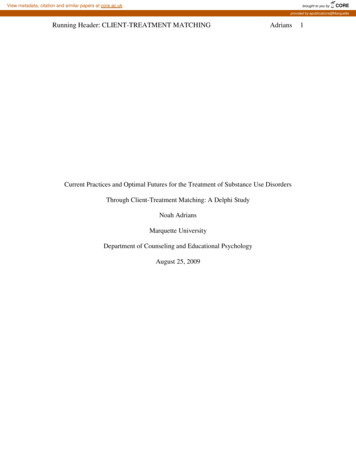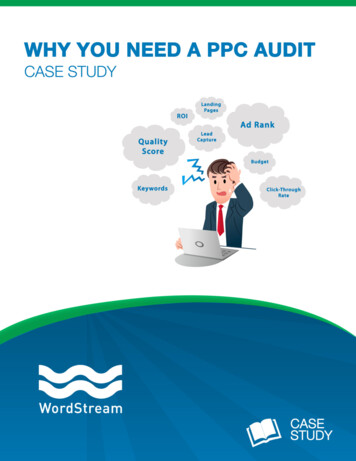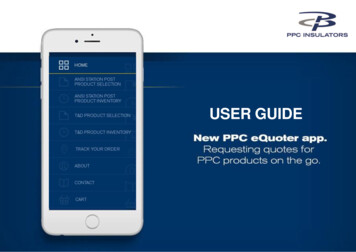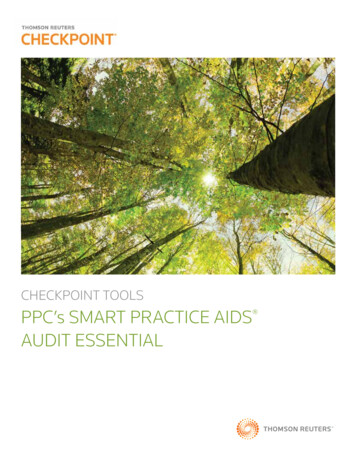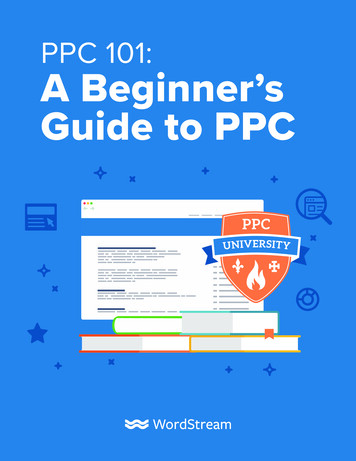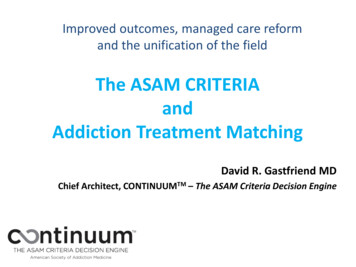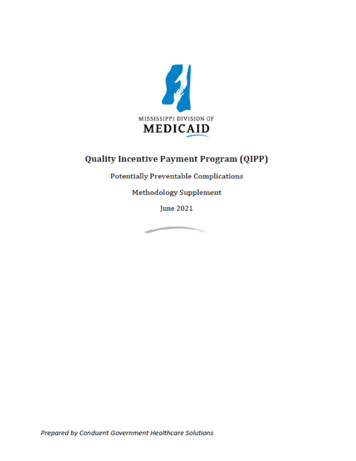
Transcription
Mississippi QIPP PPC Methodology SupplementGlossary and AcronymsWeighted actual-to-expected ratioThe weighted actual-to-expected ratio compares thecombined weight of potentially preventable complications(PPCs) that occur during inpatient admissions at yourhospital to the weight of expected PPCs for an averagehospital nationwide with the same mix of DRGs andseverity of illness. For more information on how the actualto-expected ratio is calculated, see Section 2.3: MeasuringPPC performance.All Patient Refined DiagnosisRelated Groups (APR-DRGs)3M grouping approach for inpatient admissions. APR-DRGsmay also be referred to as DRGs.At-risk inpatient admissionAn initial inpatient stay that may or may not include one ormore PPCs. At-risk inpatient admissions exclude inpatientadmissions that met the criteria for global exclusions, suchas stays for APR-DRGs that have a particularly high rate ofexpected complications (see globally excluded conditionsbelow). In addition, each PPC has a set of PPC-specificclinical exclusions, which means that the number of at-riskadmissions varies by PPC.Corrective Action Plan (CAP)CAPs will be required for hospitals that are above the PPCperformance threshold on the July report of the second yearof each PPC cycle. CAPs will be based on a templatedistributed by the Division of Medicaid when hospitalsrequiring CAPs are identified.Globally excluded conditionsWhen measuring the PPC rate, several conditions which areexpected to have a high rate of unpreventable complicationsare excluded from consideration. These conditions includemajor trauma, metastatic malignancies, HIV, many neonatalanomalies and COVID-19. These conditions are excludedfrom the consideration as at-risk inpatient stays for all PPCsexcept PPC 45, Post-Procedural Foreign Bodies andSubstance Reaction.Potentially preventablecomplications (PPCs)PPCs identify potentially preventable complications thatoccur during an inpatient stay. There are 55 PPCs that areincluded in the Quality Incentive Payment Program (QIPP)PPC program ranging from Stroke and IntracranialHemorrhage to Catheter-Related Urinary Tract Infection.The list of PPCs can be found in Table 4.1 at the end of thisdocument.QIPPQuality Incentive Payment Program, a Division of Medicaidprogram that bases a portion of Mississippi Hospital AccessProgram (MHAP) payments on quality indicators.Severity of Illness (SOI)In the APR-DRG inpatient grouping algorithm, inpatientstays are assigned a severity of illness which differentiatesJune 2021i
Mississippi QIPP PPC Methodology Supplementthe severity and resource requirements of the inpatient stay.The SOI generally reflects the extent of the patient’scomorbidities and can be affected by inpatientcomplications.State Fiscal Year (SFY)June 2021Each state fiscal year runs from July 1 through the followingJune 30.ii
Mississippi QIPP PPC Methodology SupplementTable of ContentsGlossary and Acronyms . iTable of Contents . iii1Measuring Complications . 12Methodology Overview . 2342.1Data. 22.2Identifying PPCs. 22.3Measuring PPC Performance . 32.4Timeline and Milestones . 42.5Performance Incentives . 5Interpreting Your Hospital’s QIPP PPC Hospital Report . 63.1Cover. 63.2Performance Measurement . 63.3Hospital Summary . 63.4Chart Performance . 73.5PPC List . 73.6PPC Detail . 8Statewide Performance . 9NotesJune 2021.15iii
Mississippi QIPP PPC Methodology Supplement1Measuring ComplicationsHospitals intend to provide patient care that is safe, evidence-driven and high quality. Nonetheless,complications of care can arise which are costly, lower quality, and lead to poor patient outcomes.Examples of such complications are hospital-acquired infections, surgical complications, and falls.The Potentially Preventable Complications (PPC) component of the Mississippi Quality IncentivePayment Program (QIPP) takes a population-based approach to measuring complications todetermine if complications occur more often than would be expected. The QIPP PPC approach isbased on the Potentially Preventable Complications algorithm developed by 3MTM (3M PPC). The3M PPC algorithm identifies 57 separate complications ranging from major (e.g. MyocardialInfarction, Pulmonary Embolism) to “monitor” (Renal Failure without Dialysis and ClostridiumDifficile Colitis). Not every complication identified by the 3M PPC algorithm can be prevented,even with optimal care. The population-based approach reflects the expectation that hospitals withhigher-than-expected complication rates have room to improve the quality of care they provide.The 3M PPC approach is broader than the CMS Provider Preventable Conditions approach (whichfocuses on “never” events); is clinically specific; provides categorical results that are easy tointerpret; and is designed for an all patient population. The 3M PPC approach has previously beenused by Maryland and Texas. 1 This approach was chosen because we believe it provides acomprehensive view into inpatient complications.QIPP PPC Hospital Reports provide insight into your hospital’s overall PPC performance and howit compares to national averages for the same patient mix. Performance is measured using aweighted actual-to-expected ratio. The weighted actual-to-expected ratio compares your hospital’sperformance to the national average for a hospital with the same patient mix (see Section 2.3 for adescription of how the weighted actual-to-expected ratio is calculated). The weights used incalculating the actual-to-expected ratio represent the expected relative cost of each PPC and reflectthe fact that some complications are more serious and costly than others. Weighted actual-toexpected ratios greater than 1 indicate your hospital performed worse than the national average,while values less than 1 indicate your hospital performed better than the national average.The initial QIPP PPC Hospital Report describes PPC performance during calendar years 2019 and2020. Unlike the QIPP Potentially Preventable Hospital Return program, the QIPP PPC programuses two years of data to measure PPC performance; using two years of data improves the stabilityof the measurement from reporting period to reporting period. The first year of QIPP PPC reportsare designed to increase awareness of your hospital’s PPC performance. After the first year ofreporting, the Division of Medicaid will identify hospitals that have the most room to improve.These hospitals will be required to submit a corrective action plan (CAP) that demonstrates thesteps they will take to reduce their hospital’s PPC performance. Hospitals required to submit CAPswill have two years to implement their CAPs and improve their PPC performance before financialpenalties are applied.June 20211
Mississippi QIPP PPC Methodology Supplement2Methodology Overview2.1DataEach QIPP PPC report will cover a two-year period. QIPP PPC reports will be provided on aquarterly basis; each report will advance the reporting period by three months. Reports will bedistributed six months after the end of the reporting period. For example, the first QIPP PPC reportwill cover calendar years 2019 and 2020 and will be released during the first week of July 2021.This delay period allows for the submission and processing of the inpatient claims that provide thedata for the 3M PPC algorithm.2.2Identifying PPCsThe 3M PPC methodology is an algorithm based on claims data submitted by hospitals forpayment. PPCs are identified based on: a combination of principal or secondary diagnosis, sometimes in combination with length of staycriteria procedures that were performed within a specific time period relative to the admission date, and a combination of secondary diagnoses that are not present on admission.Although complex, the algorithm is available through the 3M PPC Definitions manual forinspection by hospitals, health plans, and others with an interest in the details of its operation.Mississippi hospitals serving Medicaid patients can access the 3M PPC Definitions manual atwww.aprdrgassign.com. For information on creating an aprdrgassign account, please emailQIPP@medicaid.ms.gov.Not every inpatient stay is considered at-risk for hospital complications. In studies of hospitalcomplications, an “at-risk admission” refers to an inpatient stay that may or may not include acomplication of care, but that doesn’t meet the exclusion criteria. Inpatient stays can be excludeddue to “global” or PPC-specific clinical characteristics. Some types of inpatient stays are at highrisk for unavoidable complications, such as stays for HIV/AIDS, major or metastatic cancer ormultiple traumas. Because complications during such stays are likely unavoidable, these stays areglobally excluded from consideration for PPC identification. The exception to the global exclusionsis PPC 45, post-procedural foreign bodies and substance reaction. PPC 45 is assigned regardless ofglobal exclusions if the stay meets the appropriate diagnostic criteria. Global exclusions are definedby a combination of APR-DRG, age, diagnosis codes, and present on admission indicators. For acomplete list of criteria that are used to assign global exclusions, see the section on “Identifyglobally excluded admissions” in the 3M PPC definitions manual.In addition to global exclusions, the PPC algorithm considers PPC-specific exclusions based onpatient age and clinical characteristics. For example, post-operative complications are specific tosurgical inpatient stays; non-surgical inpatient stays would not be considered at-risk for thesePPCs. For this reason, the number of at-risk inpatient admissions varies for each PPC. The PPCList tab in your hospital’s PPC report indicates how many inpatient stays were considered at riskfor each PPC. For more information on how PPC exclusions are identified, see the section on“Apply PPC-specific exclusion criteria” in the 3M PPC definitions manual.June 20212
Mississippi QIPP PPC Methodology SupplementAll inpatient stays that did not qualify for a global exclusion and did not meet the PPC-specificexclusion criteria are considered at-risk for a PPC. Each inpatient stay can be at-risk for more thanone PPC and can have more than one PPC assigned. However, in cases where an inpatient staymeets the criteria for multiple related PPCs, the more serious PPC is assigned.There are 57 unique PPCs ranging from PPC 01, Stroke and intracranial hemorrhage to PPC 66,Catheter-related urinary tract infection (evolution of the PPC algorithm has led to discontinuationof some PPCs over time, leading to non-contiguous PPC numbers). Two of the PPCs, 21(Clostridium Difficile Colitis) and 24 (Renal Failure without Dialysis) are not included in hospitalperformance measurement; these PPCs tend to be coded inconsistently from hospital-to-hospitalmaking it difficult to compare hospital performance. These PPCs are included in a “Monitor only”section of the PPC report for your review. While comparing performance on these “monitor only”PPCs across hospitals is not meaningful, tracking spikes or sudden changes in these PPCs overtime can provide useful insights into your hospital’s quality of care. A full list of PPCs can bedownloaded from the Division of Medicaid Quality Improvement ives/.2.3Measuring PPC PerformanceThe most straightforward way to evaluate complications is to measure the complication rate,calculated as the number of PPC occurrences divided by the number of stays at-risk for a PPC. Wereport the PPC rate for each type of complication on the PPC List tab of your hospital’s report.However, because the number of at-risk stays varies for each PPC, the overall PPC rate in apopulation is difficult to interpret, making it unsuitable to capture overall hospital performance. Inaddition, the expected rate of PPCs for a given hospital varies based on the mix of admission APRDRGs, with more acute inpatient stays expected to experience more complications. Thus, a highPPC rate could reflect a hospital with more complications than expected, or it could simply reflecta hospital that treats a more acute population.In order to control for the effect of inpatient acuity on the number of complications, we measureoverall PPC performance by comparing the PPCs that occurred at a given hospital to the PPCs thatwere expected to occur based on national PPC rates for the same mix of DRGs and severity ofillness (SOI). The national PPC rates are published by 3M and are based on a nationwide dataset ofinpatient stays from Medicare, Medicaid and commercial payers. This dataset specifies theexpected rate of PPCs for each PPC/DRG/SOI combination. By aggregating over the hospital’smix of DRG/SOIs, we can calculate the expected number of each PPC. Comparing the actualnumber of PPCs to the expected number of PPCs gives us the actual-to-expected ratio (A/E ratio).The A/E ratio tells us whether there were more of a given PPC than would be expected based onnational averages. A/E ratios greater than 1 indicate there were more PPCs than expected based onthe national average, while A/E ratios less than 1 indicate there were fewer PPCs than expected.To measure overall hospital performance, we aggregate both the actual and expected PPCs acrossall PPC types. However, some PPCs are more serious and costly than others and should have alarger influence on measures of hospital performance. For example, PPC 35, Septicemia and OtherSevere Infections, would be expected to be more costly and have worse patient outcomes than PPC65, Urinary Tract Infection. We use the 3M estimates of relative PPC cost (adjusted for the averageAPR-DRG casemix in the MS Medicaid population) as weights in the aggregation of actual andexpected PPCs. A PDF containing a description of each PPC and its relative cost weight can befound on the Division of Medicaid Quality program website: e 20213
Mississippi QIPP PPC Methodology SupplementHospital overall performance is measured as a weighted sum of actual PPCs divided by theweighted sum of expected PPCs and is referred to as the weighted A/E ratio. Table 2.3.1 providesan example of this approach using 3 PPCs. For each PPC, the PPC weight is multiplied by thenumber of times that PPC occurred, resulting in the “Actual PPC Weight.” Next, the PPC weight ismultiplied by the number of expected PPC occurrences to calculate the “Expected PPC Weight.”The Weighted A/E Ratio is calculated as the Actual PPC Weight divided by the Expected PPCweight. As with the unweighted A/E ratio, weighted A/E ratios greater than 1 indicate room toimprove, while A/E ratios less than 1 indicate performance that was better than the nationalaverage. Each hospital’s PPC report provides the overall weighted A/E ratio as the primarymeasure of hospital performance on the hospital summary tab. The PPC List tab provides thenumber of actual and expected PPCs for each PPC type and calculates the number of “excess”PPCs (actual PPCs – expected PPCs). In addition, the PPC List tab provides the relative costweight for each PPC type.Table 2.3.1Example of Overall Hospital Performance CalculationAdjustedPPC WeightExpectedActual PPCPPC WeightWeight(Weight XActual (Weight X Expected ExpectedNumber Number of Number Number ofof PPCs PPCs)of PPCs PPCs)WeightedA/E Ratio(Actual PPCWeight/ExpectedPPC Weight)PPCDescription01Stroke & Intracranial Hemorrhage0.6352685.087.95.031.0102Extreme CNS Complications0.3256020.652.80.910.7103Acute Pulmonary Edema and RespiratoryFailure without 40.83Overall Performance:2.4Timeline and MilestonesPPC performance reporting will occur in four-year cycles. A PPC cycle is a period of four yearsthat includes an initial year of “baseline” reports followed by identification of hospitals that need tosubmit a corrective action plan, two years for corrective action plan implementation plus a sixmonth runout period, and then identification of performance incentive payments. A new cyclestarts each state fiscal year (SFY). The cycles overlap such that the second cycle's initial reportingyear will cover the same time period as the first cycle's first corrective action plan implementationyear. Each QIPP PPC report will list your hospital's performance for each of the currently activecycles.June 20214
Mississippi QIPP PPC Methodology Supplement2.5Performance IncentivesPPC performance accounts for 10% of your hospital’s QIPP funds in SFY 2022 (40% isdetermined by Potentially Preventable Hospital Return performance, and 50% is aligned with theHospital Information Network initiative).The at-risk amount of your hospital’s QIPP PPC payments depend on your hospital’s weightedactual-to-expected ratio. The higher the weighted actual-to-expected ratio, the more of your QIPPPPC funds are at-risk.Low RangeWeighted Actual-to-ExpectedRatio: 1.000 1.100 1.200 1.300HighRange 1.000 1.100 1.200 1.300At Risk % ofQIPP PPC funds0%25%50%75%100%For the first four quarters of each PPC cycle, hospital representatives are required to attest that theyhave received and reviewed the QIPP PPC report to receive their QIPP PPC funds. Hospitals thatare required to submit a corrective action plan (CAP) will be identified based on the July report ofthe second year in each cycle. CAPs are due by the following September 1 and should follow thetemplate distributed with the QIPP PPC report. Hospitals that are required to submit a CAP but failto do so by the CAP deadline will not receive their quarterly QIPP PPC funds. Hospitals withCAPs have two years to improve their QIPP PPC performance by 1% to receive 50% of their atrisk funds, or 2% to receive 100% of their at-risk funds. Hospital will need to meet all criteria of allcurrently active cycles to receive all their QIPP PPC funds.June 20215
Mississippi QIPP PPC Methodology Supplement3Interpreting Your Hospital’s QIPP PPC Hospital ReportYour hospital’s report contains six separate tabs: Cover, Performance Measurement, HospitalSummary, Chart Performance, PPC List Cycle 1, and PPC Detail Cycle 1. This section of theMethodology summary contains an overview of each section.3.1CoverThe cover tab identifies your hospital’s current performance and contains overview informationhelpful in reviewing the rest of the report. Note the glossary of key terms at the bottom of the tab;this glossary will help you understand the terminology we use throughout the report.3.2Performance MeasurementThe performance measurement tab describes QIPP cycles and the performance incentivethresholds, as well as listing the key dates and performance requirements for each of the currentlyactive PPC cycles.3.3Hospital SummaryThe hospital summary tab provides an overview of your hospital’s performance in each of thecurrently active PPC cycles. The notes section at the top provides information about each of themetrics in the hospital performance section. The Hospital Performance section below the notescontains several PPC measurements specific to your hospital. Each quarter in a given cycle is listedso you can see how your PPC performance is changing over time. The following bullet pointsdescribe each of the PPC measurements. The number of total inpatient admissions indicates the number of inpatient stays that wereincluded in the analysis, prior to determination of whether an inpatient stay was at risk for aPPC. Not all inpatient stays were at risk for each PPC. Inpatient admissions where the patient isexpected to be at high risk for unavoidable complications, such as patients with metastaticmalignancy, HIV/AIDS, or major trauma, were excluded from the group of at-risk inpatient staysfor all PPCs except PPC 45, Post-Procedural Foreign Bodies and Substance Reaction. COVID19 inpatient stays are also excluded from consideration as at-risk admissions. In addition to theseglobal exclusions, specific clinical logic was applied for each PPC to determine whether a giveninpatient stay was at-risk for that particular PPC. The number of at-risk stays therefore differedfor each PPC, making a global count of at-risk stays such as that used in the PotentiallyPreventable Hospital Returns (PPHR) component of the QIPP program meaningless. For moreinformation about the number of at-risk admissions for individual PPCs, see the PPC List tab. The number of potentially preventable complications listed on the hospital summary tabindicates how many PPCs were identified during the reporting period at your hospital. Note thatmore than one PPC can occur during a given inpatient stay; inpatient stays with more than sixPPCs are excluded from analysis as they may represent catastrophic illness and the PPCs may beless likely to be preventable. The count of PPCs includes all PPC types except PPC 21,clostridium difficile colitis, and PPC 24, renal failure without dialysis. These two PPCs representJune 20216
Mississippi QIPP PPC Methodology Supplementcomplications for which there is significant coding variation across hospitals, making PPCperformance difficult to interpret. The PPC rate varies by PPC. A PPC rate is calculated by dividing the number of PPCs identifiedduring the reporting period by the number of at-risk inpatient admissions. Because the number ofat-risk admissions is different for each PPC based on PPC-specific clinical exclusions, reportingthe PPC rate for each PPC is more meaningful than reporting an overall PPC rate. For PPCspecific rates, see the PPC List tab. The actual PPC weight metric reflects the overall PPC performance at your hospital, weightedusing 3M’s relative cost weights. PPCs vary in how serious and costly they are to treat. Theweights reflect the expected relative cost of each PPC and are based on the fact that some PPCsrequire more resources to treat, and are associated with worse outcomes, than others. PPCweights are based on 3M national relative cost weights, adjusted for a MS Medicaid population.For more information on PPC cost weights, see section 2.3. The expected PPC weight reflects the expected PPC performance for the DRG/SOI mix at yourhospital. The expected number of PPCs is based on estimated national PPC norms from aMedicare, Medicaid and commercial population. The expected PPCs are weighted using 3M’srelative cost weights. The weighted actual-to-expected ratio compares the weighted value of PPCs at your hospital tothe weighted expected value based on the national norms published by 3M. Weighted actual-toexpected values less than the statewide target indicate your hospital performed better than theMississippi average, while values greater than the statewide target indicate that your hospital hasroom to improve. Note that weighted actual-to-expected ratios are not calculated for low volumehospitals that have fewer than 10 expected PPCs.3.4Chart PerformanceThe chart performance tab has one chart for each of the current reporting cycles. Each chart showsthe weighted actual-to-expected ratio over time since the beginning of the cycle. The grey pointsrepresent the statewide target. If your hospital is performing better than the statewide target, theorange points will be below the gray points. If your hospital’s performance is above the gray pointsat the beginning of the second year of the cycle, your hospital will be required to submit acorrective action plan. If performance does not then improve by X% over the next two years, yourhospital will lose the at-risk portion of the QIPP PPC funds.3.5PPC List55 of the 57 PPCs are included in the MS Medicaid PPC performance metric (PPC 21, ClostridiumDifficile Colitis and 24, Renal Failure without Dialysis, are excluded due to statisticalunreliability). The PPC list tab provides details for each of these PPC types, including the PPC description the PPC group the MS Medicaid PPC weight, which reflects the relative cost of each PPC the number of inpatient stays during the reporting period that were at risk for that specific PPC(each PPC has its own unique set of clinical exclusion criteria)June 20217
Mississippi QIPP PPC Methodology Supplement the number of times that PPC occurred the rate of occurrence for the PPC the number of expected occurrences for the PPC type, based on the 3M national rate ofoccurrence for the same mix of DRGs/SOI the number of excess PPCs, calculated as the number of times a PPC type occurred minus thenumber of expected occurrences for that PPC type. Excess PPCs in this column are highlightedred if there more occurrences than expected, and green if there were fewer occurrences thanexpected the excess PPC weight, calculated as the actual PPC weight (number of PPCs multiplied by PPCweight) minus the expected PPC weight. Excess PPC weight in this column is highlighted red ifthe PPC weight was higher than expected, and green if the PPC weight was lower than expected.The PPC list can be sorted by the number of excess PPCs or by the excess PPC weight (actual PPCweight – expected PPC weight) to identify the PPCs where your hospital could improve, or toidentify those PPCs where your hospital is performing well.The PPC List tab also provides details for two PPC types that are not included in the performancemetric: PPC 21, Clostridium Difficile Colitis and PPC 24, Renal Failure without Dialysis.Diagnostic coding for these two PPC types is highly variable across hospitals, which means there issignificant performance variability. The Division of Medicaid recommends that you monitorperformance on these PPCs over time and investigate any unexpected spikes in the occurrence ofthese PPCs.3.6PPC DetailThe PPC detail tab lists information for the inpatient stays that included a PPC. Informationincludes the medical record number and/or the managed care identification number, the patientMedicaid identifier, dates of service, the admission APR-DRG and DRG description, the numberand description of the PPC, the MS Medicaid cost weight for the PPC, and whether the inpatientstay occurred during the most recent quarter. Note that some inpatient stays include more than onePPC; in such cases the inpatient stay is listed multiple times, once for each unique PPC assigned tothe stay.June 20218
Mississippi QIPP PPC Methodology Supplement4Statewide PerformanceTo provide context for your hospital’s results, we analyzed MS Medicaid statewide performanceduring calendar years (CYs) 2019 and 2020. During this time period, MS Medicaid patientsexperienced 2,665 PPCs, with a total PPC weight of 1,747 (average PPC weight of 0.66). Incomparison, national norms suggest that 2,719 PPCs with a combined weight of 1,593 (averagePPC weight of 0.59) would be expected for the same mix of DRGs/SOI over that time period.Overall, the PPC weighted actual-to-expected ratio was 1.10, or 10% higher than expected. Thisvalue suggests that, although there were slightly fewer PPCs in MS Medicaid than would beexpected based on national norms, the PPCs that occurred tended to have higher weights than theaverage PPC nationally. The higher weights mean that PPCs had a larger impact on MS Medicaidstays than would be expected based on national averages.Table 4.1 illustrates statewide performance on the 55 PPCs that are included in the QIPP PPCperformance metric. PPC 65, Urinary Tract Infection, was the most common PPC, with 223instances in the baseline dataset; performance on this PPC was somewhat better than expected,with an actual-to-expected ratio of 0.89. PPC 35, Septicemia and Severe Infections was the mostexpensive PPC, due to both a high prevalence and a higher-than-average relative cost weight.Performance on PPC 35 (Septicemia and Severe Infections) was worse than expected, with 13%more instances than were expected based on national averagesThe initial QIPP PPC statewide target will be a weighted actual-to-expected ratio of 1.0, setting agoal of 10% better performance than MS-sta
The initial QIPP PPC Hospital Report describes PPC performance during calendar years 2019 and 2020. Unlike the QIPP Potentially Preventable Hospital Return program, the QIPP PPC program uses two years of data to measure PPC performance; using two years of data improves the stability of the measurement from reporting period to reporting period.

